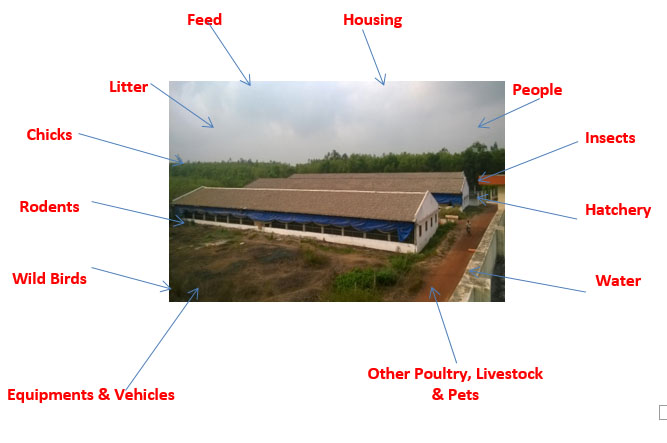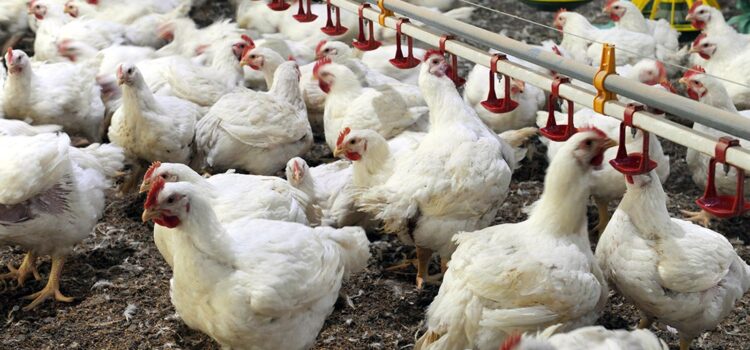Good Broiler performance means More Body weight, More Liveability & Low FCR. With today’s increasing operational Cost one more parameter become very important; Mean Age. We need to produce 7 Flocks in a year to sustain. Therefore, today’s Broiler performance only means EEF or BEF.

The more the EEF, the better is Broiler Performance.

Poultry Consultant
We need More Body Weight. But in India, Bangladesh & Nepal, live bird market scenario, Body Weight need to match the customer demand which is 2 to 2.20Kg now. More Body weight means more EEF.
We want more broiler Liveability which depends on several factors like
- Breeder Management: Health, Age, and Vaccination Program.
- Hatchery Management: Sanitation, Hatch Window, Temperature & Ventilation management.
- Farm Management: Brooding, Vaccination Program & Health management.
- Biosecurity.
More Liveability = Less Mortality, means more EEF.
Mean Age is the average age of culling or selling the birds. Less no of days to reach Targeted Body Wt means less overheads, less Feed, less water & less mortality. Low Mean age means high EEF.

In simple terms FCR means the amount of Feed required to produce one Kg Live Broiler. Hence, Lower the FCR better the EEF.
Considering current scenario with increasing Feed Cost (which accounts 67-70% of Broiler Cost) FCR is the most important parameter in broiler farming. Again FCR is directly related to Body Weight vis-a-vis Mean Age & Health status of birds. Practically both Body Wt & FCR are directly depends on Average Daily Weight Gain (ADG). Faster Growth yields more ADG results more Body Wt in less no of days with Less Feed (low FCR) & Less Overhead expenses.
Hence we can conclude that better Broiler Performance is only possible with better ADG means more EEF. Therefore, the issues are; how to get More Liveability & MORE Av Day Gain?
LIVEABILITY
Increase Liveability or reduce mortality is not just a subject to read or write. It is a continuous process of husbandry practise (Farm Management), health management, Vaccination program & Veterinary practise considering receipt of active & healthy Day Old Chicks (DOC).
Several factors related to Breeder farm operation directly affect broiler liveability which includes:
-
Age of Parent Stock: Early Chick Mortality & Lameness is common with chicks from young flocks. Chicks from old age flocks have relatively less Immune power and frequently suffer from disease outbreaks. Chicks from middle aged breeder flocks perform excellently.
- Vaccination Program: Breeder Vaccination program should aim not only to protect the parent stock but also to provide enough immune strength to progeny considering the local disease history & challenges. The diseases like CIA, REO, ND, IBD, IB, Salmonellosis & Mycoplasmosis need to taken seriously at breeder level. Presently IBH auto vaccines are being used in breeder to prevent outbreaks in progeny with questionable success.

-
Health Status of parent Stock: It is not only related with Parent Liveability & no of Settable Hatching Eggs but also quality of DOC. Chicks must be free from vertically transmitted diseases like Salmonella (Pullorum or Gallinerum), Mycoplasmosis (CRD) and AE (Avian Encephalomylitis) etc. Moreover, general health status of breeder flock directly responsible for broiler performance. Healthy breeder means high liveability in broiler.
-
Sanitation of Breeding Farm: Cleanliness & sanitation of breeding farm in general, Egg collection team & Egg Store, vehicles affect broiler liveability. Egg shell can carry infections which ultimately results poor liveability.
Many issues of Hatchery & Chick Transportation are directly responsible for broiler liveability:
Sanitation is very important subject in hatchery management which not only affect hatchery performance (Saleable Chick %) but also produce Sick Chicks which eventually dies in few days after reaching broiler farm.
-
Infections of Staphylococcus & E coli are very commonly carried by chicks from hatchery resulting Omphalytis with early chick mortality.
-
Mycoplasma from eggs of one flock can infect eggs of other flocks in hatchery producing CRD after 21 days age.
-
Similarly Salmonella infection can horizontally transmit to other hatching eggs in the hatchery resulting high mortality in early life (both embryonic & first few days of broiler).
-
Fungal Infection (Aspergillosis or Brooder Pneumonia) in chicks are mostly brought from hatchery (infected chick box, paper pieces & vehicle) causing very high mortality with low body weight and poor performance.
Hatch Window is very important not only for hatch% but also for the Liveability of Chicks at farm. Extended Hatch window is a common problem resulting Lameness & respiratory distress with Ascites in later stage. The chicks born in the first part are worst performer.
Ventilation is major management issue in hatchery. Air Space between two Incubators and between Machine & Wall must be sufficient enough for continuous Oxygen supply inside the machines.

Husbandry practice & Farm management is the main issue behind High Liveability. A chick from best breeder & good hatchery fails due to poor farm management. Further, good husbandry & farm management many times gives beyond expected results from ordinary breeder & poor hatchery practice. The following issues need to be taken care for better liveability:
a) Shed Ready:- Housing of Chicks only after making the farms free from all source of Disease. Pre-Heating of brooding house helps improving liveability.

b) Chick Receiving:- Unloading, counting & releasing immediately on reaching farm increases liveability.

c) Immediate Access of chicks to Fresh Feed & Water with good Probiotic and making them accustomed with brooding house not only reduce early chick mortality but also helps development of immune system to minimize later stage disease outbreak.

d) Brooding Management to provide comfort to newly arrived chicks with respect to Space, Litter (bedding), Temperature, Ventilation (Air Circulation) & Light.

e) Scientific Vaccination & Medication program considering disease history of the area & present challenges involving Poultry Veterinarian.
Biosecurity & Health Management is directly related to Liveability. Exposure to disease need to be checked to improve liveability.

DAY GAIN (ADG):
Average Daily Weight Gain (ADG) depends on our capacity & ability to extract the bird’s Genetic potential through Nutrition, Husbandry practise & Farm Management.
NUTRITION: Today’s good nutrition not only depends on
1) Best Formulation &
2) Good quality Raw Materials
but also on
3) Production Efficiency like Grinding, Mixing, Pelleting, Conditioning etc.
4) Physical Presentation like Particle Size, Hardness, Dust%, Moisture% etc.
5) Storage Efficiency like Downtime, Technique, System, etc.

6) Feeding Management at Farm e.g. Equipment status, Feed Consumption, Feeding method, Water quality, Farm Sanitation and Health Management.
# Minimum the storage time, maximum is the ADG & EEF. Fresh Feed offers 100% Nutrients availability to the broiler resulting excellent ADG. Storing feed for long in air-tight godown shall be avoided. Under Hot & Humid Indian scenario Pellet/Crumb feed should be consumed within 7 days.
# Equipment Quality:
Feeder Type – Best is Chick Tray followed by Big Feeder or Automatic Feeder with Conveyer system. Feeder No should be 1 for 50 chicks in Big Feeder and 1 for 40 Chicks in Automatic Feeder.

Feeder Line Distance: Distance between 2 lines should not be more than 10 Feet because broilers are lazy & reluctant to move beyond 5 feet.
Feeding Method has direct impact on quantity of Feed Intake & on its digestion. Meal Feeding or Intermittent Feeding through lighting management gives high ADG resulting excellent FCR & EEF.
# Water Quality:
The Chicken body consist of 70% water and water is the medium by which Nutrients & Oxygen transportation takes place in the body. Water Quality impacts heavily on ADG & EEF.
The pH should be around 6 for better ADG. Organic Acids as liquid water Acidifier helps reducing pH. The Hardness shall be below 100 and Water should be free from dissolved Heavy metals. Water should be free from any chemical & microbial contamination.
# Farm Sanitation & Health Management:
Healthy bird eats as per breed standard and grows as per genetic potential. Maintenance of perfect health is the key of success in today’s broiler. The birds need to be protected from diseases
a) Causing High Mortality e.g. ND, IBD, IBH, IB, AI, Salmonellosis, Aspergillosis, etc
b) Causing Moderate Mortality but affecting ADG e.g. E coli, Mycoplasma, Staphylococcus, etc and
c) Causing Little or No Mortality but affects ADG e.g. Coccidiosis, Mycotoxins, Sub-Clinical IBD, Necrotic Enteritis.
These can be achieved through
- a) Strict Biosecurity:-
- Poultry Traffic Control by restricting unwanted visitor to farm specially poultry related person.
- Fencing with Effective Footbath at Entrance.
- Do not keep any other domestic animal or birds in the farm complex.
- Disposal of Dead birds in Death Pit with disinfectant. Awareness needed to stop selling Sick & dead birds in market which not only infects the vehicle but also spread the disease in other areas. Feeding Dead birds to dogs or Fish is only inviting and aggravating our problem.

- b) Scientific Vaccination, Disinfection & Medication program as given by Poultry Veterinarian.
- c) Daily Health monitoring; any abnormally shall be dealt with scientific approach.
- d) Daily Water & Feed Intake monitoring; any deviation shall be looked seriously
- e) Keeping the Farm Complex clean and free from organic debris which harbour infections.
Author: Dr B C Dutta, Poultry Consultant, www.drbcdutta.com
Note: This article was earlier published in West Bengal Poultry Mela Souvenir, February 2017.
Article by same author: Lameness In Poultry – Contributing Factors






